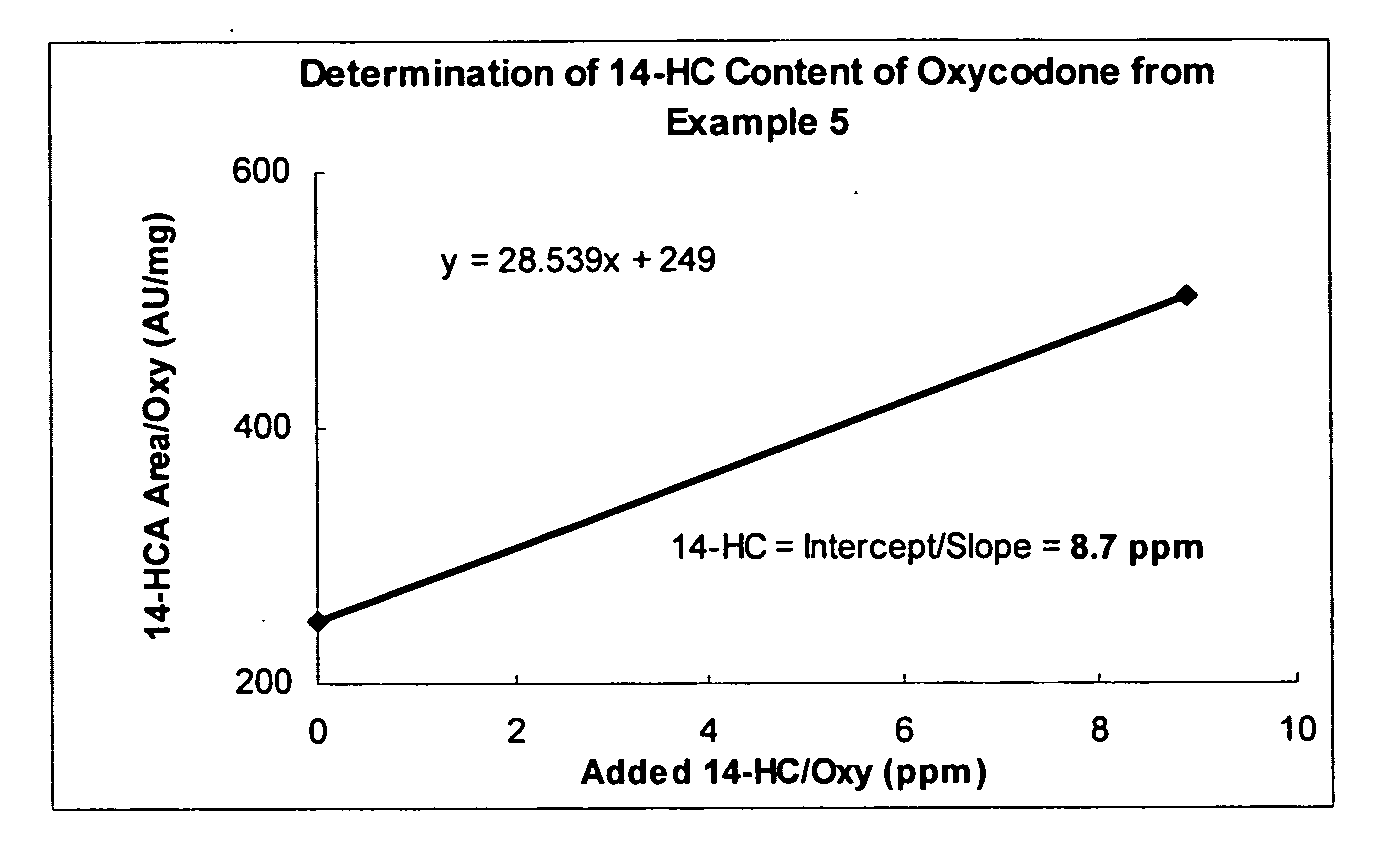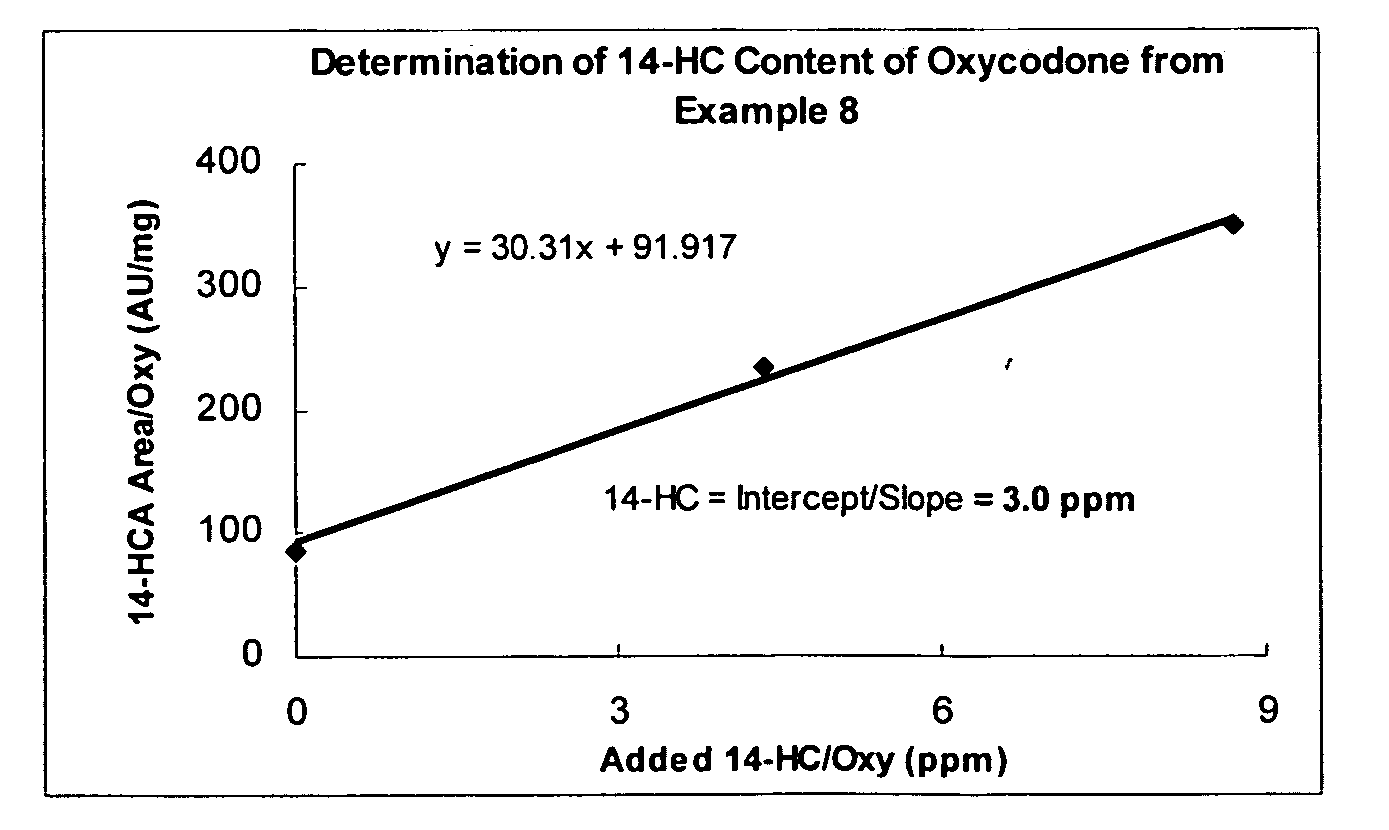Process for reducing contaminating Michael acceptor levels in oxycodone and other compositions
a technology of michael acceptor and oxycodone, which is applied in the direction of drug compositions, instruments, testing food, etc., can solve the problems of undesirable intake of michael acceptors by living organisms, food or other compositions that might contain michael acceptors, etc., and achieve the effect of reducing water solubility and water solubility
- Summary
- Abstract
- Description
- Claims
- Application Information
AI Technical Summary
Benefits of technology
Problems solved by technology
Method used
Image
Examples
example 1a
Removal of 14-hydroxycodeinone from an Oxycodone Composition
[0085] This example describes treatment of an oxycodone free base composition containing more than 300 ppm but less than 1000 ppm of 14-hydroxycodeinone with 20 mM sodium thioglycolate at pH 6 to effect (together with other operations) removal of 14-hydroxycodeinone and the thiol-Michael adduct, and produce a processed product containing less than 10 ppm of 14-hydroxycodeinone.
[0086] An oxycodone sample containing more than 300 ppm of 14-hydroxycodeinone was dissolved in water at pH 6.0 to produce a 7.5% solution (75 mg / mL) using 4 M HCl to effect neutralization and dissolution of the oxycodone to pH 6. Sufficient solid EDTA and solid sodium thioglycolate were added to bring the concentrations of these components in the reaction mixture to 2 mM EDTA and 20 mM thioglycolate. The pH was maintained at pH 6.0, at room temperature for 2.8 hours, after which time the reaction mixture was raised to pH 9 to precipitate the oxycod...
example 1b
Removal of 14-hydroxycodeinone from an Oxycodone Composition with 20 mM Sodium Thioglycolate
[0087] This example describes treatment of an oxycodone free base composition containing 3525 ppm of 14-hydroxycodeinone with 20 mM sodium thioglycolate to effect (together with other operations) a more than 800-fold reduction in 14-hydroxycodeinone content of the composition and produce a product wherein the sum of the 14-hydroxycodeinone and the 2-(oxycodone-8-sulfanyl)-acetic acid content was less than 5 ppm.
[0088] Oxycodone (5.0 g, 15.9 mmol) containing 3525 ppm of 14-hydroxycodeinone was dissolved in 50 mL of 0.33 N HCl. The pH of the resulting solution was raised to 6.1-6.2 by addition of 1 M sodium carbonate with stirring. After dissolution of any oxycodone that precipitated during the addition of the sodium carbonate, sodium thioglycolate, chosen as a thiol-containing compound (0.114 g, 1 mmol) was added. The resulting solution was stirred for 1 h and then solid sodium carbonate (1....
example 2
Determination of the Sum of 14-hydroxycodeinone Content and the 2-(oxycodone-8-sulfanyl)-acetic Acid Content of the Oxycodone Product of Example 1B
[0089] The oxycodone product of EXAMPLE 1B (0.5 g, 1.6 mmol) was dissolved in 0.2 N HCl (10 mL). Ethylenediamineteraacetic acid (EDTA) (0.005 g, 0.017 mmol) was added and the solution pH was raised to 6.1-6.2 with 1 M sodium carbonate with stirring to dissolve any precipitated oxycodone. To the homogeneous reaction mixture was added sodium thioglycolate (0.025 g, 0.22 mmol). In separate spike experiments known amounts of 14-hydroxycodeinone were introduced prior to addition of sodium thioglycolate. After 1.5 h, the pH of the solution was raised to 8.2-8.4 with 1 M sodium carbonate (˜1.6 mL) and the suspension was extracted with dichloromethane (2×15 mL) in a 30 mL separatory funnel. The aqueous layer was separated and acidified with 1 N HCl (1.7 mL) to pH 2.6-3.6. An aliquot (2 mL) of the predetermined volume of the aqueous -solution (15...
PUM
| Property | Measurement | Unit |
|---|---|---|
| Fraction | aaaaa | aaaaa |
| Fraction | aaaaa | aaaaa |
| Fraction | aaaaa | aaaaa |
Abstract
Description
Claims
Application Information
 Login to View More
Login to View More - R&D
- Intellectual Property
- Life Sciences
- Materials
- Tech Scout
- Unparalleled Data Quality
- Higher Quality Content
- 60% Fewer Hallucinations
Browse by: Latest US Patents, China's latest patents, Technical Efficacy Thesaurus, Application Domain, Technology Topic, Popular Technical Reports.
© 2025 PatSnap. All rights reserved.Legal|Privacy policy|Modern Slavery Act Transparency Statement|Sitemap|About US| Contact US: help@patsnap.com



